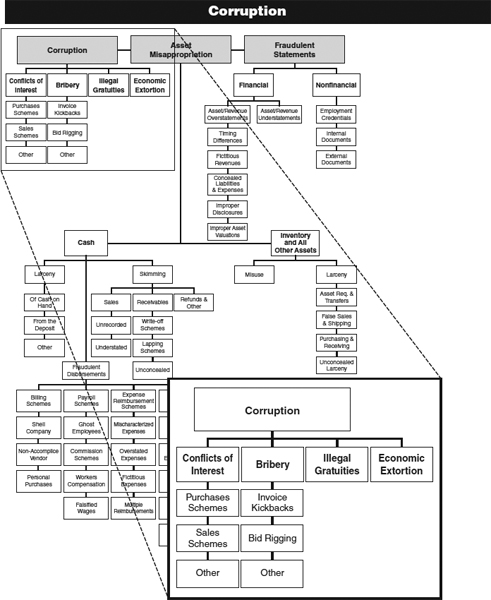
EXHIBIT 10-1
CHAPTER 10
CORRUPTION
LEARNING OBJECTIVES
After studying this chapter, you should be able to
| 10-1 | Define corruption |
| 10-2 | Identify the four categories of corruption |
| 10-3 | Define bribery |
| 10-4 | Compare and contrast bribery, extortion, and illegal gratuities |
| 10-5 | Identify the two categories of bribery schemes |
| 10-6 | Understand kickback schemes and how they are committed |
| 10-7 | Understand bid-rigging schemes and explain how they are categorized |
| 10-8 | Describe the types of abuses that are committed at each stage of the competitive bidding process |
| 10-9 | Be familiar with the controls and techniques that can be used to prevent and detect bribery |
| 10-10 | Define conflicts of interest |
| 10-11 | Differentiate conflicts of interest from bribery schemes and billing schemes |
| 10-12 | List and understand the two major categories of conflicts of interest |
| 10-13 | Understand the provisions of U.S. and U.K. anti-corruption legislation |
| 10-14 | Be familiar with proactive audit tests that can be used to detect corruption schemes |
CASE STUDY: WHY IS THIS FURNITURE FALLING APART?1
A number of years ago, the Washington Post ran a series of articles detailing charges of waste, fraud, and abuse in the General Services Administration (GSA), the federal government's housekeeping agency. In particular, for more than a decade a furniture manufacturer in New Jersey had churned out $200 million ...
Get Principles of Fraud Examination, 4th Edition now with the O’Reilly learning platform.
O’Reilly members experience books, live events, courses curated by job role, and more from O’Reilly and nearly 200 top publishers.

